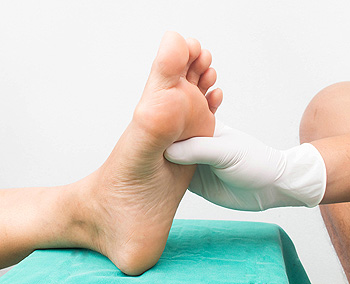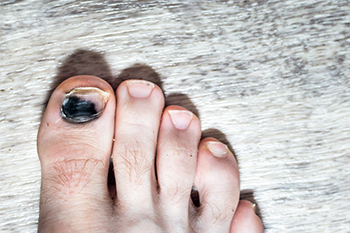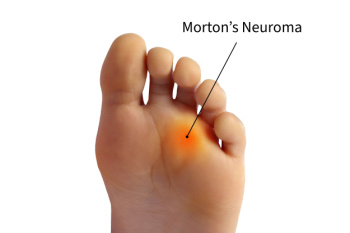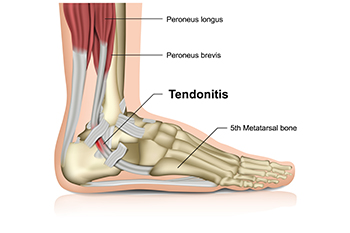Blog
Items filtered by date: September 2025
Pros and Cons of Treadmill Running

Running on a treadmill offers both benefits and drawbacks when it comes to the health of your feet. A treadmill provides a predictable surface, which can reduce the risk of tripping on uneven ground. It also may lessen impact on the ankles and toes compared to running on harder outdoor surfaces. The consistent motion of the belt can also help runners refine cadence, allowing shorter strides that place less strain on the feet and lower legs. However, treadmill running does not engage all of the stabilizing muscles around the feet and ankles in the same way as outdoor running, which may reduce strength in those areas over time. The repetitive motion can also place added pressure on the balls of the feet, leading to soreness or stress injuries. A podiatrist can assess running style, provide guidance on footwear, and recommend treatment if injuries develop. If you experience foot pain after running, it is suggested that you make an appointment with a podiatrist for an exam, diagnosis, and treatment.
Exercising your feet regularly with the proper foot wear is a great way to prevent injuries. If you have any concerns about your feet, contact Timothy Gauldin, DPM of Toe-tal Foot Care. Our practitioner will treat your foot and ankle needs.
How to Prevent Running Injuries
Many common running injuries are caused by overuse and overtraining. When the back of the kneecap starts wearing out and starts causing pain in your knee, this is commonly referred to as runner’s knee. Runner’s knee is a decrease in strength in your quadriceps and can occur if you’re not wearing properly fitted or supporting shoes. To prevent runner’s knee, focusing on hip strengthening is a good idea, as well as strengthening your quads to keep the kneecaps aligned.
What Are Some Causes of Running Injuries?
- One cause of a common running injury is called iliotibial band syndrome.
- Plantar fasciitis is also another common injury.
- Stress fractures can occur from overtraining, lack of calcium, or even your running style.
Best Ways to Prevent Running Injuries
- Wear footwear that fits properly and suits your running needs.
- Running shoes are the only protective gear that runners have to safeguard them from injury.
- Make a training schedule. Adding strengthening exercises as well as regular stretching can help keep you strong and limber and can lessen the possibility of injuries.
- Stretching keeps muscles limber; this will help you gain better flexibility.
If you have any questions, please feel free to contact our office located in Hot Springs, AR . We offer the newest diagnostic and treatment technologies for all your foot care needs.
Get Proper Treatment for Ankle Injuries
Causes of Nerve Pain in the Feet

Nerve pain in the feet often develops when nerves become compressed or damaged, leading to discomfort that may interfere with walking and daily activity. Morton’s neuroma, a common cause, occurs when tissue thickens around nerves between the toes, creating burning or stabbing sensations in the ball of the foot. Tarsal tunnel syndrome involves compression of the posterior tibial nerve near the ankle, which can cause tingling, numbness, or shooting pain along the sole. Baxter’s neuropathy results from pinching of a nerve under the arch, sometimes linked to flat feet, heel spurs, or chronic strain. Diabetes can lead to diabetic neuropathy, producing sharp, burning pain or numbness in the toes that may spread up the legs over time. Even conditions such as sciatica may radiate pain into the feet. A podiatrist can diagnose the source of nerve pain and suggest the appropriate treatment, which in some cases may include surgery. If you have symptoms of neuropathy in your feet, it is suggested that you make an appointment with a podiatrist for an exam and treatment.
Neuropathy
Neuropathy can be a potentially serious condition, especially if it is left undiagnosed. If you have any concerns that you may be experiencing nerve loss in your feet, consult with Timothy Gauldin, DPM from Toe-tal Foot Care. Our practitioner will assess your condition and provide you with quality foot and ankle treatment for neuropathy.
What Is Neuropathy?
Neuropathy is a condition that leads to damage to the nerves in the body. Peripheral neuropathy, or neuropathy that affects your peripheral nervous system, usually occurs in the feet. Neuropathy can be triggered by a number of different causes. Such causes include diabetes, infections, cancers, disorders, and toxic substances.
Symptoms of Neuropathy Include:
- Numbness
- Sensation loss
- Prickling and tingling sensations
- Throbbing, freezing, burning pains
- Muscle weakness
Those with diabetes are at serious risk due to being unable to feel an ulcer on their feet. Diabetics usually also suffer from poor blood circulation. This can lead to the wound not healing, infections occurring, and the limb may have to be amputated.
Treatment
To treat neuropathy in the foot, podiatrists will first diagnose the cause of the neuropathy. Figuring out the underlying cause of the neuropathy will allow the podiatrist to prescribe the best treatment, whether it be caused by diabetes, toxic substance exposure, infection, etc. If the nerve has not died, then it’s possible that sensation may be able to return to the foot.
Pain medication may be issued for pain. Electrical nerve stimulation can be used to stimulate nerves. If the neuropathy is caused from pressure on the nerves, then surgery may be necessary.
If you have any questions, please feel free to contact our office located in Hot Springs, AR . We offer the newest diagnostic and treatment technologies for all your foot care needs.
Causes and Treatment of Black Toenail

A black toenail can be concerning because it may develop from a variety of causes, ranging from trauma to underlying health issues. The most common cause of a blackened toenail is injury. Stubbing the toe or repeated pressure from shoes can trap blood under the nail and cause it to darken. Runners often experience this type of injury, sometimes called runner’s toe. Discoloration may also signal a fungal infection, where organisms thrive under the nail and can lead to thickening or brittleness. Ingrown toenails or bacterial infections can cause similar toenail changes. Medical conditions like diabetes, circulation problems, or even vitamin deficiencies may also contribute to nail darkening. Rarely, melanoma, a form of skin cancer, may appear as a dark streak under the toenail. A podiatrist can examine the toenail and order appropriate tests. Treatment may involve draining trapped blood, addressing infection, or, in severe cases, surgery. If you notice discoloration of a toenail, it is suggested that you schedule an appointment with a podiatrist for an evaluation and appropriate treatment.
Toe pain can disrupt your daily activities. If you have any concerns, contact Timothy Gauldin, DPM of Toe-tal Foot Care. Our practitioner can provide the care you need to keep you pain-free and on your feet.
What Causes Toe Pain?
Most severe toe pain is caused due to a sports injury, trauma from dropping something heavy on the toe, or bumping into something rigid. Other problems can develop over time for various reasons.
Toe pain can be caused by one or more ailments. The most common include:
- Trauma
- Sports injury
- Wearing shoes that are too tight
- Arthritis
- Gout
- Corns and calluses
- Hammertoe
- Bunions
- Blisters
- Ingrown toenails
- Sprains
- Fractures (broken bones)
- Dislocations
When to See a Podiatrist
- Severe pain
- Persistent pain that lasts more than a week
- Signs of infection
- Continued swelling
- Pain that prevents walking
Diagnosis
In many cases the cause of toe pain is obvious, but in others, a podiatrist may want to use more advanced methods to determine the problem. These can range from simple visual inspections and sensation tests to X-rays and MRI scans. Prior medical history, family medical history, and any recent physical traumatic events will all be taken into consideration for a proper diagnosis.
Treatment
Treatments for toe pain and injuries vary and may include shoe inserts, padding, taping, medicines, injections, and in some cases, surgery. If you believe that you have broken a toe, please see a podiatrist as soon as possible.
If you have any questions please contact our office located in Hot Springs, AR . We offer the newest diagnostic and treatment technologies for all your foot and ankle needs.
What You Should Know About Morton's Neuroma

Morton's neuroma is a painful condition that affects the ball of the foot, most commonly between the third and fourth toes. It is caused by thickening of the tissue surrounding a nerve that leads to the toes, often due to repetitive stress, wearing tight footwear or high heels. Foot deformities like flat feet or bunions can also be factors. Symptoms may include sharp, burning pain, or the sensation of having a pebble inside the shoe. The pain often worsens with activity or pressure and may subside when the shoes are removed. A podiatrist can diagnose Morton's neuroma through a physical exam, symptom review, and imaging such as ultrasound or an MRI scan. Treatment options include footwear modifications, custom orthotics, anti-inflammatory medications, or, in severe cases, surgical removal of the affected nerve. Early diagnosis can prevent the condition from worsening. If you are experiencing persistent forefoot pain or numbness, it is suggested that you schedule an appointment with a podiatrist for an expert evaluation and relief.
Morton’s neuroma is a very uncomfortable condition to live with. If you think you have Morton’s neuroma, contact Timothy Gauldin, DPM of Toe-tal Foot Care. Our practitioner will attend to all of your foot care needs and answer any of your related questions.
Morton’s Neuroma
Morton's neuroma is a painful foot condition that commonly affects the areas between the second and third or third and fourth toe, although other areas of the foot are also susceptible. Morton’s neuroma is caused by an inflamed nerve in the foot that is being squeezed and aggravated by surrounding bones.
What Increases the Chances of Having Morton’s Neuroma?
- Ill-fitting high heels or shoes that add pressure to the toe or foot
- Jogging, running or any sport that involves constant impact to the foot
- Flat feet, bunions, and any other foot deformities
Morton’s neuroma is a very treatable condition. Orthotics and shoe inserts can often be used to alleviate the pain on the forefront of the feet. In more severe cases, corticosteroids can also be prescribed. In order to figure out the best treatment for your neuroma, it’s recommended to seek the care of a podiatrist who can diagnose your condition and provide different treatment options.
If you have any questions, please feel free to contact our office located in Hot Springs, AR . We offer the newest diagnostic and treatment technologies for all your foot care needs.
Common Achilles Tendon Injuries and How to Find Relief

The Achilles tendon is the strongest tendon in the body, connecting the calf muscles to the heel bone, yet it is prone to painful injuries. Achilles tendinopathy is a condition marked by stiffness, swelling, and discomfort along the tendon, often caused by overuse or repetitive stress. A sudden rupture, or break, occurs when the tendon tears, usually with sharp pain and difficulty walking or pushing off the foot. These injuries typically occur in the back of the ankle, just above the heel. A podiatrist can provide a thorough evaluation, advanced treatments, and guidance for safe recovery. If you are experiencing Achilles tendon pain or have sustained an injury, it is suggested that you consult this type of doctor who can accurately diagnose and effectively treat this condition.
Achilles tendon injuries need immediate attention to avoid future complications. If you have any concerns, contact Timothy Gauldin, DPM of Toe-tal Foot Care. Our practitioner can provide the care you need to keep you pain-free and on your feet.
What Is the Achilles Tendon?
The Achilles tendon is a tendon that connects the lower leg muscles and calf to the heel of the foot. It is the strongest tendon in the human body and is essential for making movement possible. Because this tendon is such an integral part of the body, any injuries to it can create immense difficulties and should immediately be presented to a doctor.
What Are the Symptoms of an Achilles Tendon Injury?
There are various types of injuries that can affect the Achilles tendon. The two most common injuries are Achilles tendinitis and ruptures of the tendon.
Achilles Tendinitis Symptoms
- Inflammation
- Dull to severe pain
- Increased blood flow to the tendon
- Thickening of the tendon
Rupture Symptoms
- Extreme pain and swelling in the foot
- Total immobility
Treatment and Prevention
Achilles tendon injuries are diagnosed by a thorough physical evaluation, which can include an MRI. Treatment involves rest, physical therapy, and in some cases, surgery. However, various preventative measures can be taken to avoid these injuries, such as:
- Thorough stretching of the tendon before and after exercise
- Strengthening exercises like calf raises, squats, leg curls, leg extensions, leg raises, lunges, and leg presses
If you have any questions please feel free to contact our office located in Hot Springs, AR . We offer the newest diagnostic tools and technology to treat your foot and ankle needs.

